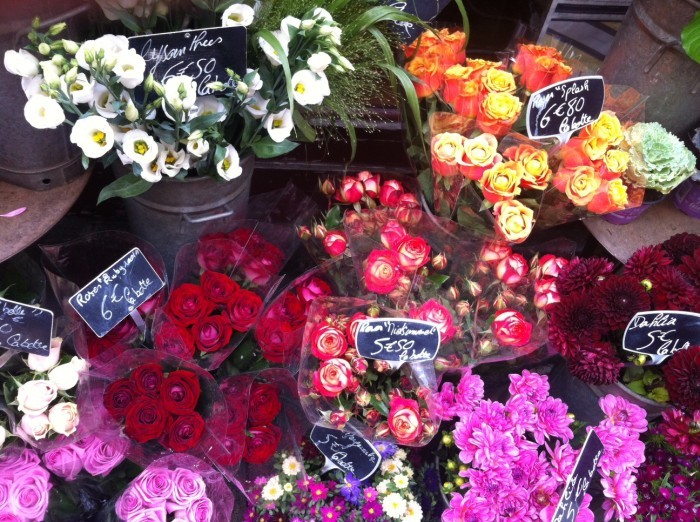Bringing fresh flowers home is a special treat for yourself and your space. Growing up, my parents would always get us flowers for our birthdays. To this day, my mom will either cut fresh flowers from her garden or buy a bouquet to put in my old childhood room when I come to visit. I love flowers, and having them in my home brings me a sense of peace and connection to the beauty in nature. Whenever I see a bouquet in the store, I’m tempted to bring it home with me, especially when there are three feet of snow outside my house, and I need a break from the vast, glaring white with the beautiful colors of the various blooms in a bouquet. But I was recently posed an interesting question, how sustainable are flowers?
I live in Colorado, and especially with the six-month-long winter we seem to experience, it is hard to believe that any of the flowers I might pick up from the grocery store are grown locally. So, where do they come from? Most flowers in the U.S. are imported. If California is having a warm year, there is a chance that the flowers might be at least based in the U.S.; however, most of the time, the delicate bouquets are imported from tropical countries such as Ecuador or Colombia. If you’re in Europe, there’s a 35% chance your flowers came from Kenya, of all places. (The African country is the #3 flower exporter in the world, and also sells to the U.S. and Russia.) This already poses a problem as millions of flowers must be transported via airplane to quickly get the blooms to us before they wilt. Still, first, they must be stored in a refrigerated warehouse to await shipment. I’m assuming that energy efficiency isn’t the top priority of most producers. In 2018, it was estimated that during the three weeks leading up to Valentine’s Day, 360,000 metric tons of carbon emissions are created from flower deliveries alone. Importing the flowers by plane obviously increases transportation emissions to get them here, but it doesn’t stop there.
Once in the U.S., the flowers are then distributed to various cities, towns, and of course, flower shops. This is done by refrigerated trucks that drive all over the United States to get them to their destinations. Refrigerated trucks use 25 % more fuel than regular trucks due to the extra energy the vehicle needs to keep cool. So this means that unless the company uses electric trucks, which are not yet common, the flower deliveries to stores, events, and even directly to our homes are creating more emissions than regular packages.
This, of course, doesn’t even begin to take into consideration the ethical practices the companies that grow these flowers have towards their workers or any pesticides or other toxic chemicals they may use. Flowers, as some of the most delicate produce, are subject to heavy pesticide use. A 2017 study found that children exposed to increased pesticides for Mother’s Day flower season showed neurobehavioral issues such as motor skills, attention, and inhibition control. The children lived in Ecuador flower farming areas, but did not work as farm workers themselves. (Yes, that’s children in Ecuador who are suffering due to our *Mother’s Day* flowers, of all holidays.) If you’re buying from a supermarket, chances are that your blooms were also sprayed heavily with pesticides. Plus, most supermarket and flower shop bouquets come wrapped in plastic and other disposable waste.
If you still want to buy your flowers (which I know I will still want to do), the best solution is to shop as local as possible. During the wintertime, some select growers will grow flowers in greenhouses. These are good to look for right now. But try to get them as close to the source as possible all year round, so the flowers don’t have to be delivered to you in a refrigerated vehicle. Slow Flowers is a great online directory that allows you to search for local flower farms and floral designers who prioritize locally grown blooms. When you work with local vendors, it’s easy to talk about organic flowers and request no plastic packaging. In the summertime, look for flowers at your local farmer’s market and support your community at the same time! Flowers from local markets are some of the most beautiful bouquets I’ve ever seen and are my favorite to receive. You can also take a page from my mom’s book and grow your own flowers in your lawn (or even patio in a pot) and take clippings before the bloom begins to wilt.
However, there are more options that will still bring beauty into your home without adding to our carbon footprint. When gifting someone flowers, consider getting them a houseplant instead (again, think local though!) or a photograph or painting of a flower that they can hang up on their wall. These gifts will last a lot longer than a bouquet, and you or the recipient doesn’t have to worry about where to compost the flowers to prevent an even larger footprint. What do you think? What will you do the next time you’re going out to buy flowers?
Get more like this—Sign up for our daily inspirational newsletter for exclusive content!
__
Photo: John-Mark Smith on Unsplash; Peaceful Dumpling






